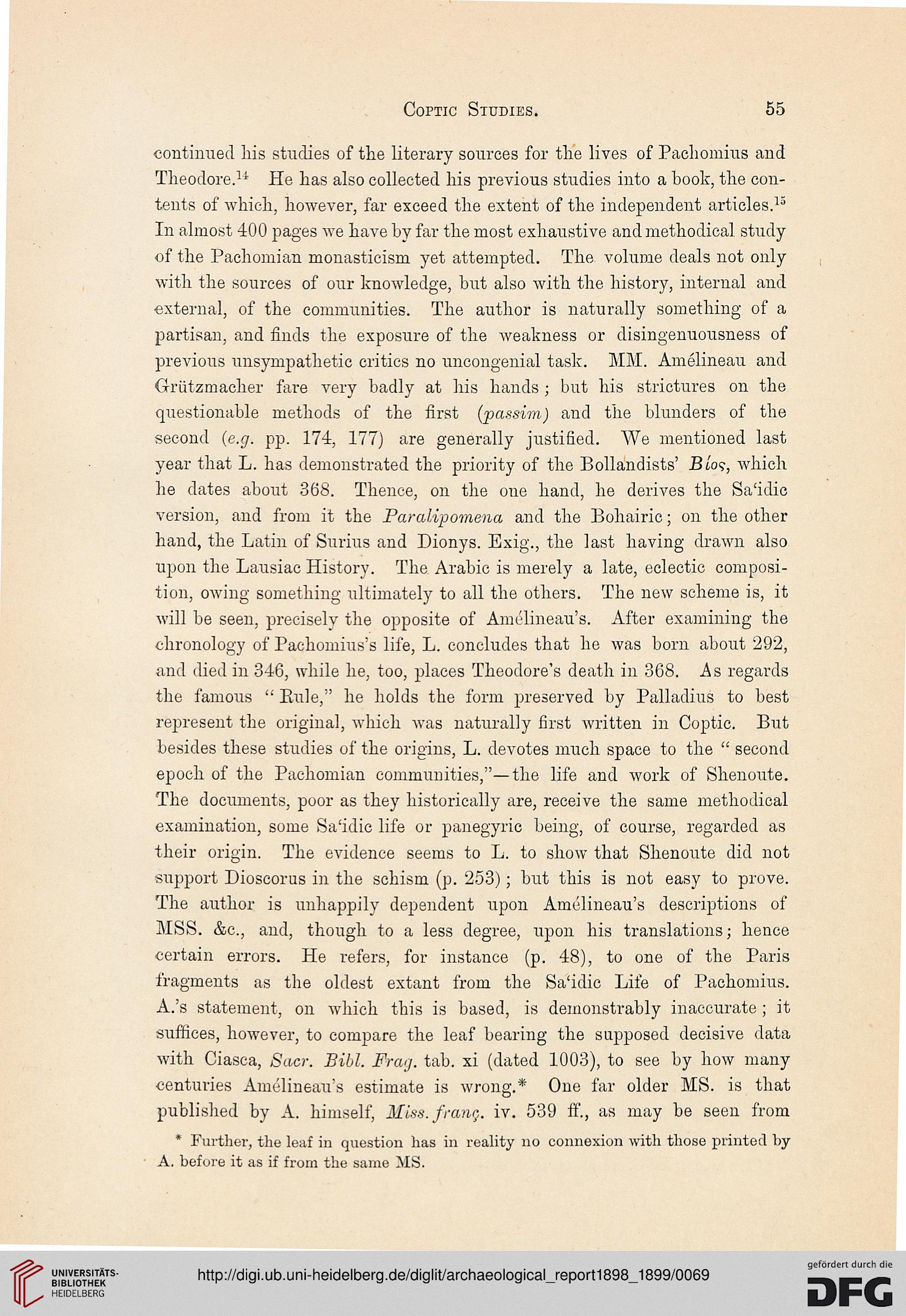Coptic Studies.
55
continued his studies of the literary sources for the lives of Pachomius and
Theodore.1* He has also collected his previous studies into a hook, the con-
tents of which, however, far exceed the extent of the independent articles.15
In almost 400 pages we have by far the most exhaustive and methodical study
of the Paehomian monasticism yet attempted. The volume deals not only
with the sources of our knowledge, but also with the history, internal and
external, of the communities. The author is naturally something of a
partisan, and finds the exposure of the weakness or disingenuousness of
previous unsympathetic critics no uncongenial task. MM. Amelineau and
Griitzmacher fare very badly at his hands ; but his strictures on the
questionable methods of the first (passim) and the blunders of the
second (e.g. pp. 174, 177) are generally justified. We mentioned last
year that L. has demonstrated the priority of the Bollandists' Bt'o?, which
he dates about 368. Thence, on the one hand, he derives the Sa'idic
version, and from it the Paralipomena and the Bohairic; on the other
hand, the Latin of Surius and Dionys. Exig., the last having drawn also
upon the Lausiac History. The Arabic is merely a late, eclectic composi-
tion, owing something ultimately to all the others. The new scheme is, it
will be seen, precisely the opposite of Amelineau's. After examining the
chronology of Pachomius's life, L. concludes that he was born about 292,
and died in 346, while he, too, places Theodore's death in 368. As regards
the famous " Kule," he holds the form preserved by Palladius to best
represent the original, which was naturally first written in Coptic. But
besides these studies of the origins, L. devotes much space to the " second
epoch of the Paehomian communities,"—the life and work of Shenoute.
The documents, poor as they historically are, receive the same methodical
examination, some Sa'idic life or panegyric being, of course, regarded as
their origin. The evidence seems to L. to show that Shenoute did not
support Dioscorus in the schism (p. 253); but this is not easy to prove.
The author is unhappily dependent upon Amelineau's descriptions of
MSS. &c, and, though to a less degree, upon his translations; hence
certain errors. He refers, for instance (p. 48), to one of the Paris
fragments as the oldest extant from the Sa'idic Life of Pachomius.
A.'s statement, on which this is based, is demonstrably inaccurate ; it
suffices, however, to compare the leaf bearing the supposed decisive data
with Ciasca, Sacr. Bibl. Frag. tab. xi (dated 1003), to see by how many
centuries Amelineau's estimate is wrong.* One far older MS. is that
published by A. himself, Miss, frang, iv. 539 ft'., as may be seen from
* Further, the leaf in question has in reality no connexion with those printed by
A. before it as if from the same MS.
55
continued his studies of the literary sources for the lives of Pachomius and
Theodore.1* He has also collected his previous studies into a hook, the con-
tents of which, however, far exceed the extent of the independent articles.15
In almost 400 pages we have by far the most exhaustive and methodical study
of the Paehomian monasticism yet attempted. The volume deals not only
with the sources of our knowledge, but also with the history, internal and
external, of the communities. The author is naturally something of a
partisan, and finds the exposure of the weakness or disingenuousness of
previous unsympathetic critics no uncongenial task. MM. Amelineau and
Griitzmacher fare very badly at his hands ; but his strictures on the
questionable methods of the first (passim) and the blunders of the
second (e.g. pp. 174, 177) are generally justified. We mentioned last
year that L. has demonstrated the priority of the Bollandists' Bt'o?, which
he dates about 368. Thence, on the one hand, he derives the Sa'idic
version, and from it the Paralipomena and the Bohairic; on the other
hand, the Latin of Surius and Dionys. Exig., the last having drawn also
upon the Lausiac History. The Arabic is merely a late, eclectic composi-
tion, owing something ultimately to all the others. The new scheme is, it
will be seen, precisely the opposite of Amelineau's. After examining the
chronology of Pachomius's life, L. concludes that he was born about 292,
and died in 346, while he, too, places Theodore's death in 368. As regards
the famous " Kule," he holds the form preserved by Palladius to best
represent the original, which was naturally first written in Coptic. But
besides these studies of the origins, L. devotes much space to the " second
epoch of the Paehomian communities,"—the life and work of Shenoute.
The documents, poor as they historically are, receive the same methodical
examination, some Sa'idic life or panegyric being, of course, regarded as
their origin. The evidence seems to L. to show that Shenoute did not
support Dioscorus in the schism (p. 253); but this is not easy to prove.
The author is unhappily dependent upon Amelineau's descriptions of
MSS. &c, and, though to a less degree, upon his translations; hence
certain errors. He refers, for instance (p. 48), to one of the Paris
fragments as the oldest extant from the Sa'idic Life of Pachomius.
A.'s statement, on which this is based, is demonstrably inaccurate ; it
suffices, however, to compare the leaf bearing the supposed decisive data
with Ciasca, Sacr. Bibl. Frag. tab. xi (dated 1003), to see by how many
centuries Amelineau's estimate is wrong.* One far older MS. is that
published by A. himself, Miss, frang, iv. 539 ft'., as may be seen from
* Further, the leaf in question has in reality no connexion with those printed by
A. before it as if from the same MS.





